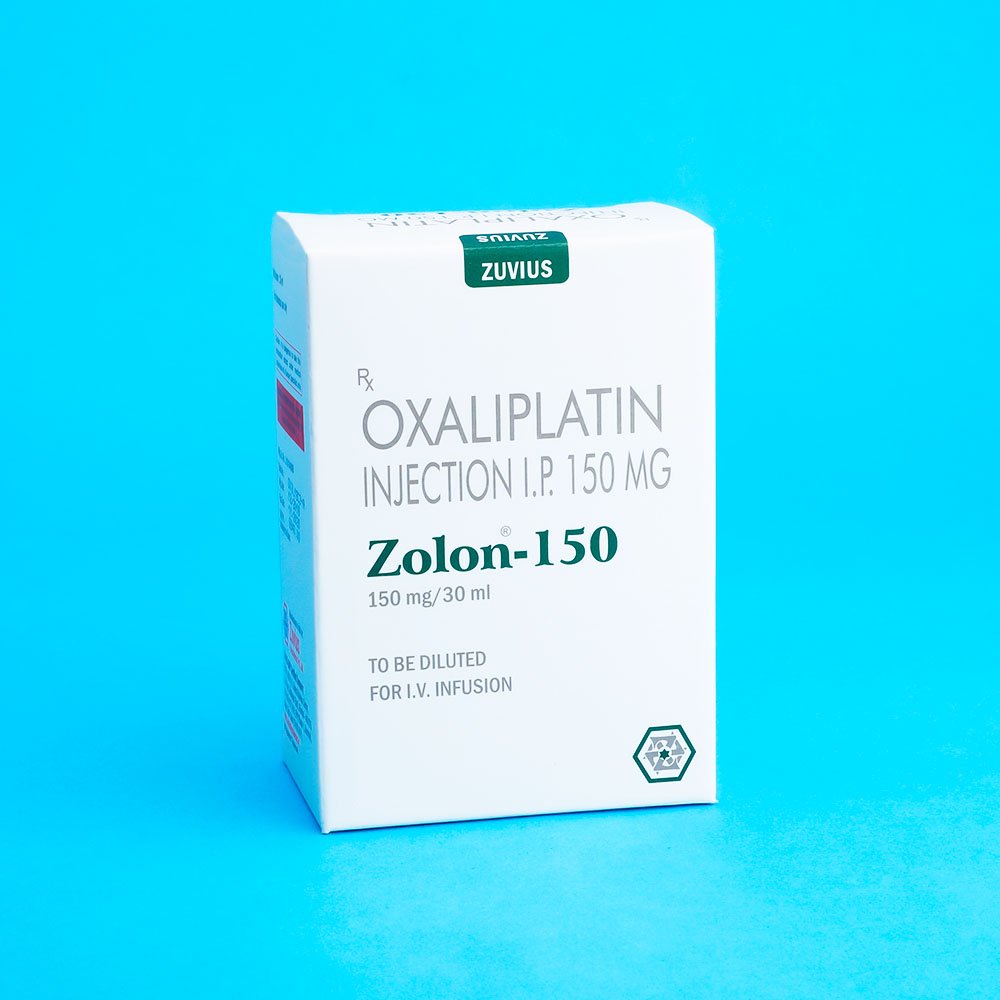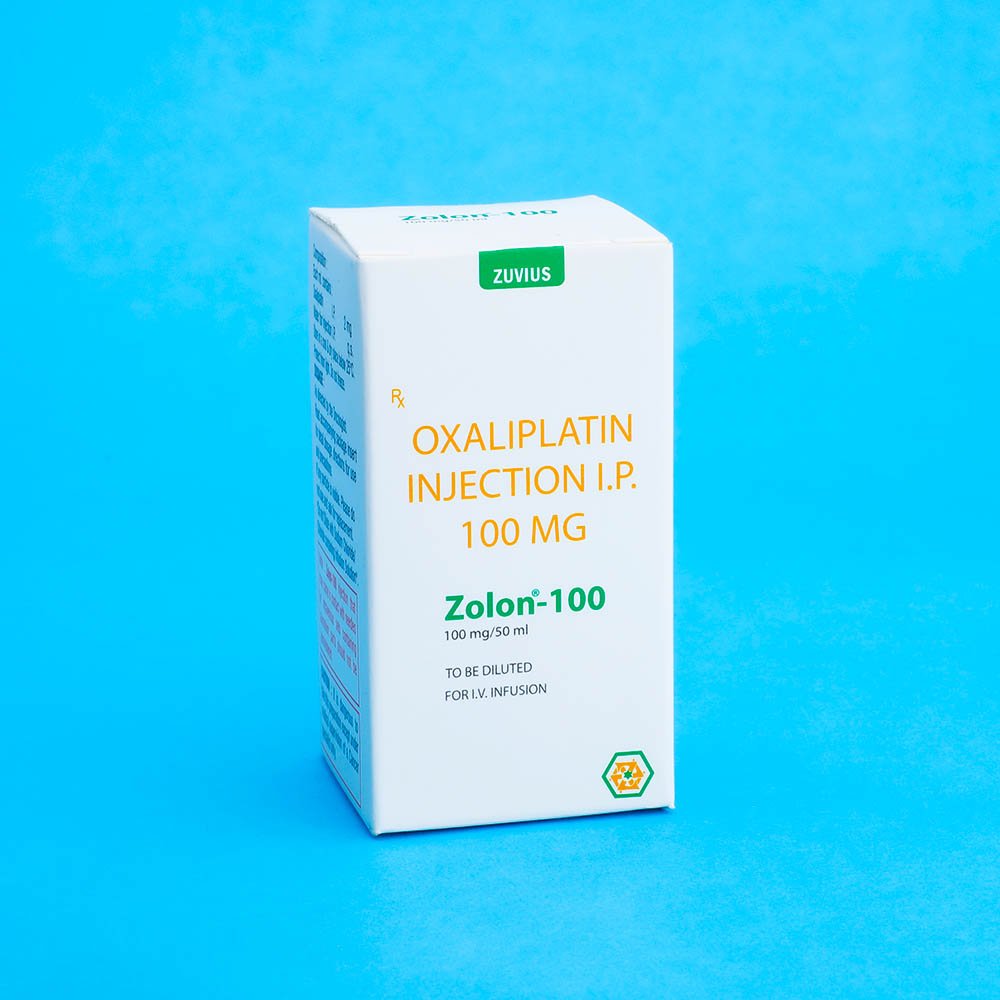Zolon- Oxaliplatin Inj
Oxaliplatin
Strength: 50mg / 100mg / 150mg
Pack Size: 1 vial
Drug Class: Other antineoplastic agents, platinum compounds
Dosage and Administration:
Colorectal Cancer In Adults
- As single agent:
- When used alone, the recommended dose of Oxaliplatin is 130mg/m2 as a continuous intravenous infusion over 2 to 6 hours. The dose may be repeated at an interval of 3 weeks.
- In combination therapy:
- IV : On day 1 : administer oxaliplatin 85 mg/m2 concurrently with leucovorin 200mg/m2 (in separate containers using a Y line) by IV infusion over 2 hours. Then administer fluorouracil 400mg/m2 by IV injection over 2 to 4 minutes, followed by fluorouracil 500mg/m2 by IV infusion over 22 hours
- On day 2 – administer leucovorin 200mg/m2 by IV infusion over 2 hours. Then administer fluorouracil 400 mg/m2 by IV injection over 2 to 4 minutes, followed by fluorouracil 600 mg/m2 by IV infusion over 22 hours. Repeat regimen at intervals of 2 weeks
Dosage adjustment in toxicity
| Symptom | Oxaliplatin dose | Fluorouracil & Leucovorin |
|---|---|---|
| Peripheral neuropathy | Administer over 6 hours | No adjustment required |
| Persistent grade 2 neurosensory effect | Reduce dose by 25% (i.e. 65mg/m) | No adjustment required |
| In patients who recover from grade 3 or 4 GI toxicity grade 4 neutropenia or grade 3 or 4 thrombocytopenia | Reduce dose by 25% ( i.e. 65mg/m) | Reduce fluorouracil dose by 20% (i.e. to 300mg/m2 by IV injection over 2 to 4 minutes and 500 mg/m2 by IV infusion over 22 hours |
- Do not administer next dose until neutrophilcourt > 1500/mm2 and platelet count > 75.000m2
Renal Impairment:
In patients with impaired renal function, observed caution
MONITORING PARAMETERS:
Assess the patients for differential WBC count, hemoglobin, platelet count, and ALT, AST, bilirubin, and creatinine level before each Oxaliplatin cycle.
Cold Storage: no
Oxalipaltin a cell cycle –phase monspecific antineoplastic drugs belongs to a new class of platinum agent that contains a platinum atom complexed with oxalate and diaminocyclothexane (DACH.)
Chemical Structure

Chemically Oxaliplatin is trans -I – diaminocyclothexane oxatatoplatinum or cis –(oxalate(trans –(1.2, -diamino-cyclothexane) platinum (III) . The empirical formula of Oxaliplatin is C₂H4 N2 O4 Pt. The molecular weight of Oxaliplatin is 397.30. Oxaliplatin is slightly soluble in water and methanol , and insoluble in ehanol.
Oxaliplatin is indicated in the treatment of metastatic colorectal cancers after failure of treatment of fluoropyrimidines , alone by monochemotherapy or along with fluoropyrimidines.
Usage:
As directed by the oncologist.
The 18% objective response rate obtained with first-line therapy confirms that the activity of single-agent oxaliplatin is comparable to other anticancer therapies considered active against colorectal cancer. Oxaliplatin undergoes nonenzymatic conversion in physiologic solutions to active derivatives via displacement of the labile oxalate ligand. Several transient reactive species are formed, including monoaquo and diaquo DACH platinum, which covalently bind with macromolecules. Both inter-and intrastrand Pt-DNA crosslinks are formed. Crosslinks are formed between the N7 positions of two adjacent guanines (GG), adjacent adenine-guanines (AG), and guanines separated by an intervening nucleotide (GNG). These crosslinks inhibit DNA replication and transcription. Cytotoxicity is cell-cycle nonspecific.
- Read the label carefully before use
- Store in a cool and dry place below 25°, protect from light. Do not freeze.
- Keep out of the reach of children
- Oxaliplatin should not be mixed with any other medication and it should not be administered simultaneously by the same infusion line.
- Caution is recommended while administering Oxaliplatin to patients with known hypersensitivity to other platinum agents.
- It is known whether oxaliplatin is excreted in human milk or not caution should be exercised when oxaliplatin is administered to a nursing woman as many drugs are excreted in human milk.
- Inspect the solution visually for particulate matter and discoloration prior to administration.





















